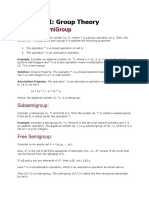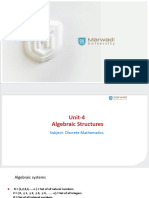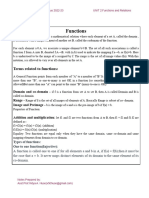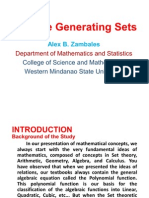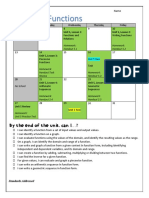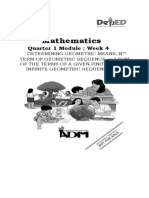Dm. Unit-5...
Dm. Unit-5...
Uploaded by
ruc200030Copyright:
Available Formats
Dm. Unit-5...
Dm. Unit-5...
Uploaded by
ruc200030Original Title
Copyright
Available Formats
Share this document
Did you find this document useful?
Is this content inappropriate?
Copyright:
Available Formats
Dm. Unit-5...
Dm. Unit-5...
Uploaded by
ruc200030Copyright:
Available Formats
According to DBATU Syllabus 2022-23 UNIT 5:Algebraic Structures and Morphism
Discrete Mathematics
Algebraic Structures and Morphism
Algebraic Structures with one Binary Operation:
The algebraic structure is a type of non-empty set G which is equipped with one or more than one binary
operation. Let us assume that * describes the binary operation on non-empty set G. In this case, (G, *) will be
known as the algebraic structure. (1, -), (1, +), (N, *) all are algebraic structures.
(R, +, .) is a type of algebraic structure, which is equipped with two operations (+ and .)
Binary Operation of Set
In the binary operation, binary stands for two. A binary operation is a type of operation that needs two inputs,
which are known as the operands. When we perform multiplication, division, addition, or subtraction
operations on two numbers, then we will get a number. The two elements of a set are associated with binary
operations. The result of these two elements will also be in the same set. So we can say that if we perform a
binary operation on a set, then it will perform calculations that combine two elements of the set and generate
another element that belongs to the same set.
Let us assume that there is a non-empty set called G. A function f from G × G to G is known as the binary
operation on G. So f: G × G → G defines a binary operation on G.
Examples of Binary operation
In this example, we will take the two natural numbers or two real numbers and perform binary operations such
as addition, multiplication, subtraction, and division on these numbers. The algebraic operation on two natural
numbers or real numbers will generate a result. If we get a natural number or real number as a result, then we
will consider that binary operation in our set.
Addition:
We will learn about addition, which is a binary operation. Suppose we have two natural numbers(a, b). Now if
we add these numbers, then it will generate a natural number as a result. For example: Suppose there are 6 and
8 two natural numbers and the addition of these numbers are
6 + 8 = 14
Hence, the result 14 is also a natural number. So, we will consider an addition in our set. The same process will
be followed for real numbers as well.
+: N + N → N is derived by (a, b) → a + b
Notes Prepared by:
Asst.Prof.Vidya A. Huse(v50huse@gmail.com)
According to DBATU Syllabus 2022-23 UNIT 5:Algebraic Structures and Morphism
Discrete Mathematics
+: R + R → R is derived by (a, b) → a + b
Multiplication:
Now we will learn multiplication, which is a binary operation. If we multiply two natural numbers (a, b), then it
will generate a natural number as a result. For example: Suppose there are 10 and 5 two natural numbers and
the multiplication of these numbers are:
10 * 5 = 50
Hence, the result 50 is also a natural number. So we will consider multiplication in our set. The same process
will be followed for real numbers as well.
+: N × N → N is derived by (a, b) → a × b
+: R × R → R is derived by (a, b) → a × b
Subtraction:
Now we will learn subtraction, which is a binary operation. If we subtract two real numbers (a, b), then it will
also generate a real number as a result. The same process will not be followed for natural numbers, because if
we take two natural numbers to perform binary subtraction, then it is not compulsory that it will generate a
natural number. For example: Suppose we take two natural numbers 5 and 7 and the subtraction of these
numbers are
5 - 7 = -2
Hence, the result is not a natural number. So we will not consider subtraction in our set.
- : R x R → R is derived by (a, b)→ a - b
Division
Now we will learn division, which is a binary operation. If we divide two real numbers (a, b), then it will also
generate a real number as a result. The same process will not be followed for natural numbers, because if we
take two natural numbers to perform binary division, then it is not compulsory that it will generate a natural
number. For example: Suppose we take two natural numbers 10 and 6 and the division of these numbers is
10/6 = 5/3
Hence, the result 5/3 is not a natural number. So we will not consider division in our set.
Notes Prepared by:
Asst.Prof.Vidya A. Huse(v50huse@gmail.com)
According to DBATU Syllabus 2022-23 UNIT 5:Algebraic Structures and Morphism
Discrete Mathematics
- : R - R → R is derived by (x, y) → x - y
Properties of Algebraic structure
Commutative: Suppose set G contains a binary operation *. The operation * is called to be commutative in G if
it holds the following relation:
x * y= y * x for all x, y in G
Associative: Suppose set G contains a binary operation *. The operation * is called to be associative in G if it
holds the following relation:
(x*y)*z = x *( y*z) for all x, y, z in G
Identity: Suppose we have an algebraic system (G, *) and set G contains an element e. That element will be
called an identifying element of the set if it contains the following relation:
x * e = e * x = x for all x
Here, element e can be referred to as an identity element of G, and we can also see that it is necessarily unique.
Inverse: Suppose there is an algebraic system (G, *), and it contains an identity e. We will also assume that the
set G contains the elements x and y. The element y will be called an inverse of x if it satisfies the following
relation:
x*y=y*x=e
Here, element x can also be referred to as inverse of y, and we can also see that it is necessarily unique. The
inverse of x can also be referred to as x-1 like this:
x * x-1 = x-1 * x = e
Cancellation Law: Suppose set G contains a binary operation *. The operation * is called to be left cancellation
law in G if it holds the following relation:
x * y = x * z implies y = z
It will be called the right cancellation law if it holds the following relation:
y * x = z * x implies y = z
Notes Prepared by:
Asst.Prof.Vidya A. Huse(v50huse@gmail.com)
According to DBATU Syllabus 2022-23 UNIT 5:Algebraic Structures and Morphism
Discrete Mathematics
Types of Algebraic structure
There are various types of algebraic structure, which is described as follows:
● Semigroup
● Monoid
● Group
● Abelian Group
All these algebraic structures have wide application in particular to binary coding and in many other
disciplines.
Semi Group
Suppose there is an algebraic structure (G, *), which will be known as semigroup if it satisfies the following
condition:
● Closure: The operation * is a closed operation on G that means (a*b) belongs to set G for all a, b ∈
● Associative: The operation * shows an association operation between a, b, and c that means a*(b*c) =
(a*b)*c for all a, b, c in G.
Example 1:
The examples of semigroup are (Matrix, *) and (Set of integer, +).
Example 2:
The semigroup contains a set of positive integers with an additional or multiplication operation. The positive
integers will not contain zero. For example: Suppose we have a set G, which contains some positive integers
except zero such as 1, 2, 3, and so on like this:
G = {1, 2, 3, 4, 5, …..}
● This set contains the closure property because according to closure property (a * b) belongs to G for
every element a, b. So in this set, (1*2) = 2 ∈
Notes Prepared by:
Asst.Prof.Vidya A. Huse(v50huse@gmail.com)
According to DBATU Syllabus 2022-23 UNIT 5:Algebraic Structures and Morphism
Discrete Mathematics
● This set also contains the associative property because according to associative property (a + b) + c = a
+ (b + c) belongs to G for every element a, b, c. So in this set, (1 + 2) + 3 = 1 + (2 + 3) = 6 ∈
Monoid:
A monoid is a semigroup, but it contains an extra identity element (E or e). An algebraic structure (G, *) will
be known as a monoid if it satisfies the following condition:
● Closure: G is closed under operation * that means (a*b) belongs to set G for all a, b ∈
● Associative: Operation * shows an association operation between a, b, and c that means a*(b*c) =
(a*b)*c for all a, b, c in G.
● Identity Element: There must be an identity in set G that means a * e = e * a = a for all x.
Example 1:
In this example, we will take (Set of integers, *), (Set of natural numbers, +), and (Set of whole numbers, +).
Where
● Monoid is shown by (Set of Integers, *) because 1 is an integer and it is also an identity element.
● Monoid is not shown by (Set of natural numbers, +) because there is not an identity element, but it is a
semigroup.
● Monoid is shown by (Set of whole numbers, +) because it contains 0 as the identity element.
Example 2:
The monoid contains a set of positive integers with additional or multiplication operations except zero. For
example: Suppose we have a set G, which contains some positive integers like 1, 2, 3, and so on like this:
G = {1, 2, 3, 4, 5, …..}
Notes Prepared by:
Asst.Prof.Vidya A. Huse(v50huse@gmail.com)
According to DBATU Syllabus 2022-23 UNIT 5:Algebraic Structures and Morphism
Discrete Mathematics
● This set contains the closure property because according to closure property (a * b) belongs to G for
every element a, b. So in this set, (1*2) = 2 and so on.
● This set contains the associative property because according to associative property (a + b) + c = a +
(b + c) belongs to G for every element a, b, c. So in this set, (1 + 2) + 3 = 1 + (2 + 3) = 5, and so on.
● This set also contains the identity property because according to this property a * e = e * a = a, where
a ∈ So in this set, (2 × 1) = 2, (3 × 1) = 3, and so on. In our case, 1 is the identity element.
Group:
A Group is a monoid, but it contains an extra inverse element, which is denoted by 1. An algebraic structure
(G, *) will be known as a group if it satisfies the following condition:
● Closure: G is closed under operation * that means (a*b) belongs to set G for all a, b ∈
● Associative: * shows an association operation between a, b, and c that means a*(b*c) = (a*b)*c for all
a, b, c in G.
● Identity Element: There must be an identity in set G that means a * e = e * a = a for all a.
● Inverse Element: It contains an inverse element that means a * a-1= a-1 * a = e for a ∈
Example 1:
The examples of group are Matrix multiplication and (Z, +).
Example 2:
In this example, we will use the matrix multiplication operation on the set of non-singular matrices N × N from
a group.
● If we perform multiplication of non-singular matrices N × N, then it will also be a non-singular matrix
N × N, which holds the property of closure.
Notes Prepared by:
Asst.Prof.Vidya A. Huse(v50huse@gmail.com)
According to DBATU Syllabus 2022-23 UNIT 5:Algebraic Structures and Morphism
Discrete Mathematics
● Matrix multiplication itself holds the property of association. So it is also associative.
● The identity matrix is contained in the set of non-singular matrices N × N, which holds the property of
identity element.
● As we have seen that all the matrices are non-singular. So they will contain the inverse elements, which
will be also non-singular matrices. Hence, it also holds the property of inverse.
Abelian Group
An abelian group is a group, but it contains commutative law. An algebraic structure (G, *) will be known as
an abelian group if it satisfies the following condition:
● Closure: G is closed under operation * that means (a*b) belongs to set G for all a, b ∈
● Associative: * shows an association operation between a, b, and c that means a*(b*c) = (a*b)*c for all
a, b, c in G.
● Identity Element: There must be an identity in set G that means a * e = e * a = a for all a.
● Inverse Element: It contains an inverse element that means a * a-1= a-1 * a = e for a ∈
● Commutative Law: There will be a commutative law such that a * b = b * a such that a, b belongs to
G.
Example: Suppose we have a set G, which contains some positive integers except zero such as 1, 2, 3, and so
on with additional operations like this:
G = {1, 2, 3, 4, 5, …..}
● This set contains the closure property because according to closure property (a + b) belongs to G for
every element a, b. So in this set, (1 + 2) = 2 ∈ G and so on.
● This set also contains the associative property because according to associative property (a + b) + c = a
+ (b + c) belongs to G for every element a, b, c. So in this set, (1 + 2) + 3 = 1 + (2 + 3) = 6 ∈ G and so
Notes Prepared by:
Asst.Prof.Vidya A. Huse(v50huse@gmail.com)
According to DBATU Syllabus 2022-23 UNIT 5:Algebraic Structures and Morphism
Discrete Mathematics
on.
● This set also contains the identity property because according to this property (a * e) = a, where a ∈
So in this set, (2 × 1) = 2, (3 × 1) = 3, and so on. In our case, 1 is the identity element.
● This set also contains the commutative property because according to this property (a * b) = (b * a),
where a, b ∈ So in this set, (2 × 3) = (3 × 2) = 6 and so on.
Notes Prepared by:
Asst.Prof.Vidya A. Huse(v50huse@gmail.com)
You might also like
- Advanced Higher Mechanics Formula List COMPLETEDocument8 pagesAdvanced Higher Mechanics Formula List COMPLETERyan_Hoyle95No ratings yet
- (VCE Methods) 2014-16 TSSM Unit 34 Exam 1Document9 pages(VCE Methods) 2014-16 TSSM Unit 34 Exam 1michael scottNo ratings yet
- Algebraic Structure in Discrete MathematicsDocument8 pagesAlgebraic Structure in Discrete Mathematicsgateh29487No ratings yet
- Algebraic Structure NotesDocument14 pagesAlgebraic Structure NotesNishant RajNo ratings yet
- Semi GroupDocument64 pagesSemi Groupsarthakchopde71No ratings yet
- DSTL Unit 2Document23 pagesDSTL Unit 2Kushagra AgrawalNo ratings yet
- DSTLDocument8 pagesDSTLPiyush SinghNo ratings yet
- Textual Learning Material - b3Document18 pagesTextual Learning Material - b3Dev RanjanNo ratings yet
- Crypto NotesDocument8 pagesCrypto NotesfacvinayNo ratings yet
- Algebaric Structure 2024Document52 pagesAlgebaric Structure 2024Saniya mhatre XII B 11No ratings yet
- Introduction To Mathematical SystemDocument4 pagesIntroduction To Mathematical SystemJerd Dela GenteNo ratings yet
- Unit 4 Algebraic Structure Question Bank Solution DM & GT DM SemDocument38 pagesUnit 4 Algebraic Structure Question Bank Solution DM & GT DM Semamoghvaishnav92No ratings yet
- Chapter XI Group TheoryDocument13 pagesChapter XI Group Theoryあなたを 食べたい鮎麻呂No ratings yet
- Activity A53 WGN1Document8 pagesActivity A53 WGN1Khyla DonatoNo ratings yet
- Group: Binary Operation in SetDocument5 pagesGroup: Binary Operation in Settbrackman99No ratings yet
- Discrete Mathematics: Submitted by Komal Applied ScienceDocument29 pagesDiscrete Mathematics: Submitted by Komal Applied Scienceabhishek kumarNo ratings yet
- Unit 2.2 Algebraic Struct Part-2Document52 pagesUnit 2.2 Algebraic Struct Part-2Vikas KumarNo ratings yet
- Groups Rings and FieldsDocument19 pagesGroups Rings and FieldsBravine MwabaNo ratings yet
- Unit6 - Algebraic Structure & Coding Theory - NMRDocument51 pagesUnit6 - Algebraic Structure & Coding Theory - NMRKimaya S NagaonkarNo ratings yet
- Unit 03 - Modern AlgebraDocument15 pagesUnit 03 - Modern AlgebraSneaky peteNo ratings yet
- Discrete-Mathematics - UNIT-5Document26 pagesDiscrete-Mathematics - UNIT-5Vishnureddy KvrNo ratings yet
- Algebraic-Structures GROUPS Feb-13Document12 pagesAlgebraic-Structures GROUPS Feb-13Ela Mae SilmaroNo ratings yet
- Lect2 Groups RecapDocument121 pagesLect2 Groups RecapVishvesh PatelNo ratings yet
- DSGTChap 5 Algebraic SystemsDocument68 pagesDSGTChap 5 Algebraic Systemsabcyz141608No ratings yet
- Algebraic Structure Unit 4Document13 pagesAlgebraic Structure Unit 4yashNo ratings yet
- Abstract AlgebraDocument8 pagesAbstract AlgebraSanket K MohareNo ratings yet
- Lecture Topic 1.2.3Document20 pagesLecture Topic 1.2.3Nojibur Rahman SojibNo ratings yet
- BSE Abstract ALGEBRA Binary GroupsDocument74 pagesBSE Abstract ALGEBRA Binary GroupsFloresa TahumNo ratings yet
- Lesson 1 Algebraic StructuresDocument4 pagesLesson 1 Algebraic StructuresSERALDYN SAMSONNo ratings yet
- Matematika Kriptografi Struktur Aljabar 2020Document44 pagesMatematika Kriptografi Struktur Aljabar 2020yohan suryaNo ratings yet
- Algrebric Structures PBDocument41 pagesAlgrebric Structures PBPATEL BHARVINo ratings yet
- Algebraic Structures2Document37 pagesAlgebraic Structures2sharran.nanda06No ratings yet
- Unit 4 DM MathsDocument59 pagesUnit 4 DM Mathsxitekol233No ratings yet
- Cns U2Document59 pagesCns U2susmitha0728No ratings yet
- Mathematics of Cryptography: Algebraic StructuresDocument68 pagesMathematics of Cryptography: Algebraic StructuresSrivathsala Suresh TangiralaNo ratings yet
- MoniodsDocument25 pagesMoniodsrere sincoNo ratings yet
- Group Theory Proofs SanitizedDocument3 pagesGroup Theory Proofs Sanitizedbachchasweets007No ratings yet
- MathspptDocument9 pagesMathspptTejaswini PhukanNo ratings yet
- 5th Unit ProblemsDocument18 pages5th Unit ProblemsDr. Ramu Kuchipudi Associate Professor (Contract)No ratings yet
- Dm. Unit-2Document24 pagesDm. Unit-2ruc200030No ratings yet
- 2.1 UST Group TheoryDocument14 pages2.1 UST Group TheorythebestNo ratings yet
- Binary CompositionDocument11 pagesBinary Compositionmumputapas5100% (3)
- Exercises From VVAcharyaDocument14 pagesExercises From VVAcharyaSajal KumarNo ratings yet
- Mathematics in The Modern World: Binary OperationDocument11 pagesMathematics in The Modern World: Binary OperationnonononowayNo ratings yet
- Ma3354 DM Unit 4 Part A, B Question and AnswerDocument8 pagesMa3354 DM Unit 4 Part A, B Question and AnswerKABILAN R.VNo ratings yet
- 21706 Binary Operations-11Document4 pages21706 Binary Operations-11Yusuf Abdul AzeezNo ratings yet
- Abstract AlgebraDocument3 pagesAbstract AlgebraLaTeXKidNo ratings yet
- Lecture 2.2.3Document7 pagesLecture 2.2.3Rohit SoniNo ratings yet
- Unit 2 - Discrete Structures - WWW - Rgpvnotes.inDocument10 pagesUnit 2 - Discrete Structures - WWW - Rgpvnotes.inAryan TamrakarNo ratings yet
- DM-Algebraic Structures - 1Document25 pagesDM-Algebraic Structures - 1PATEL BHARVINo ratings yet
- Mfcs 4th UnitDocument12 pagesMfcs 4th UnitKrishnaNo ratings yet
- Change Generating SetsDocument14 pagesChange Generating SetsZambales AlexNo ratings yet
- MCQ On Group TheoryDocument3 pagesMCQ On Group Theoryakhtargulam920No ratings yet
- Group Theory: Introduction To GroupsDocument13 pagesGroup Theory: Introduction To GroupsVon vsica100% (1)
- School of Science and Humanities Department of Mathematics: Unit - IiiDocument16 pagesSchool of Science and Humanities Department of Mathematics: Unit - IiirlkfjnsdlkNo ratings yet
- Part-A - Unit-4-2023Document2 pagesPart-A - Unit-4-2023csbs269035No ratings yet
- MTH211 SummariesDocument23 pagesMTH211 SummariesskvolybanksNo ratings yet
- Unit IIDocument54 pagesUnit IIHANISHA SAALIHNo ratings yet
- Welcome: Level: Bachelor Degree Subject: Higher Algebra Chapter: Group Theory Lesson Title: Definition of GroupDocument6 pagesWelcome: Level: Bachelor Degree Subject: Higher Algebra Chapter: Group Theory Lesson Title: Definition of GroupPuskar BistNo ratings yet
- Lecture 2.2.1Document7 pagesLecture 2.2.1Rohit SoniNo ratings yet
- CHAP09 Finitely Generated Abelian GroupsDocument20 pagesCHAP09 Finitely Generated Abelian GroupsDaniél CárdenasNo ratings yet
- Ec6405 - Control System Engineering Questions and Answers Unit - I Control System Modeling Two MarksDocument53 pagesEc6405 - Control System Engineering Questions and Answers Unit - I Control System Modeling Two MarksSaravanan Pazapughal100% (1)
- Probability For Dummies Cheat Sheet - For DummiesDocument3 pagesProbability For Dummies Cheat Sheet - For DummiesBrian O'ConnellNo ratings yet
- Chapter Two Linear Programming GraphicsDocument7 pagesChapter Two Linear Programming GraphicsAbdurehman AliNo ratings yet
- Lord Et Al 2010Document19 pagesLord Et Al 2010FilouNo ratings yet
- Slides 11 09 PDFDocument105 pagesSlides 11 09 PDFGaurav Kumar GuptaNo ratings yet
- Centroids IntegrationDocument21 pagesCentroids IntegrationdcasaliNo ratings yet
- Modal Analysis For The Connoisseur: Ron Potter and Norm Olsen, Hewlett-Packard Co., Everett, WashingtonDocument10 pagesModal Analysis For The Connoisseur: Ron Potter and Norm Olsen, Hewlett-Packard Co., Everett, Washingtonho-faNo ratings yet
- Spectral AnalysisDocument19 pagesSpectral AnalysisPatrick SibandaNo ratings yet
- A.10 GENERALIZATIONS AND REFINEMENTS FOR BERGSTROM AND RADONS INEQUALITIESDocument6 pagesA.10 GENERALIZATIONS AND REFINEMENTS FOR BERGSTROM AND RADONS INEQUALITIESSong BeeNo ratings yet
- DSP - Using Matlab - Chap2Document37 pagesDSP - Using Matlab - Chap2nguyencraft01No ratings yet
- Lesson 2-08 Properties of Normal DistributionsDocument18 pagesLesson 2-08 Properties of Normal DistributionsJamiefel Pungtilan100% (3)
- Mayer Algebra 1 Unit 5 Assignment Sheet 1Document2 pagesMayer Algebra 1 Unit 5 Assignment Sheet 1api-260343289No ratings yet
- Feb PDFDocument9 pagesFeb PDFthonguyenNo ratings yet
- Math10 Module Q1 Wk4Document13 pagesMath10 Module Q1 Wk4Geraldine RamosNo ratings yet
- Ch4 FunctionsDocument27 pagesCh4 Functionsloay abukhalafNo ratings yet
- Bini Cime PDFDocument281 pagesBini Cime PDFImron MashuriNo ratings yet
- Engineering ElectromagneticDocument2 pagesEngineering ElectromagneticPooja PatelNo ratings yet
- Volume of Solid (Bounded by 2 Surfaces of Paraboloids)Document2 pagesVolume of Solid (Bounded by 2 Surfaces of Paraboloids)Muhammad Syafieq Abd RazakNo ratings yet
- 387-398 Wibowo & PrasetyoDocument12 pages387-398 Wibowo & PrasetyoAisyah BncNo ratings yet
- Engineering Mathematics III Question BankDocument12 pagesEngineering Mathematics III Question BankMitrabhanu100% (1)
- Week 5 Notes CMTDocument4 pagesWeek 5 Notes CMTAlfredo MartínezNo ratings yet
- Probability Theory Presentation 10Document51 pagesProbability Theory Presentation 10Xing QiuNo ratings yet
- On The Odd Sieve SequenceDocument3 pagesOn The Odd Sieve SequenceDon HassNo ratings yet
- Lagrange Multipliers On Banach SpacesDocument2 pagesLagrange Multipliers On Banach SpacesAndrea SpencerNo ratings yet
- Mid-Term Exam of Differential Equations and Transforms (MTH-423), Feb-2024Document2 pagesMid-Term Exam of Differential Equations and Transforms (MTH-423), Feb-2024Maryam SafdarNo ratings yet
- 2023 Consolidation of Year 12 Work For Year 13Document8 pages2023 Consolidation of Year 12 Work For Year 13isobelhandleyNo ratings yet
- Vectors and Scalars: AP Physics BDocument13 pagesVectors and Scalars: AP Physics BVictor BritoNo ratings yet












